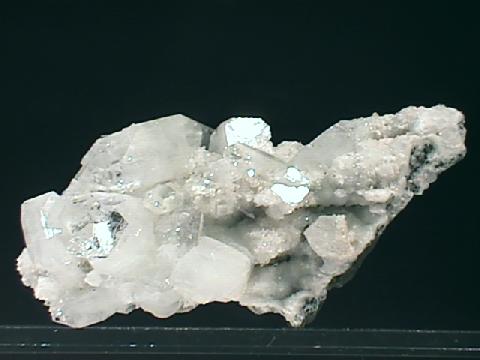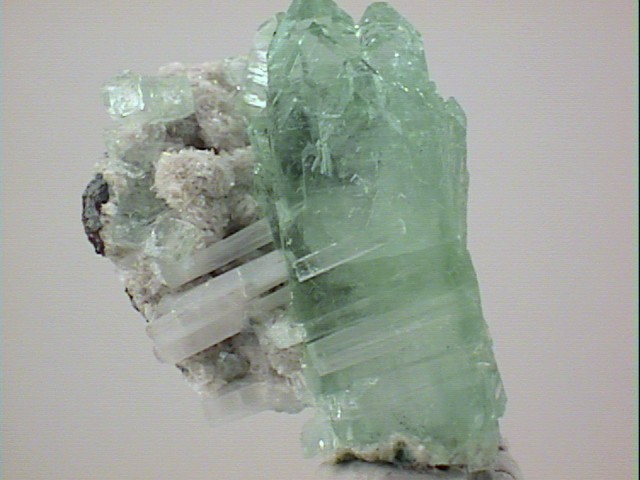 THE MINERAL APOPHYLLITE
THE MINERAL APOPHYLLITE
- Chemistry: (K,Na)Ca4Si8O20(F,OH) - 8H2O, Hydrated Potassium Calcium Sodium Silicate Fluoride Hydroxide.
- Class: Silicates
- Subclass: Phyllosilicates
- Group: Apophyllite
- Uses: Only as mineral specimens.
- Physical Properties
Specimens
Unfortunately, apophyllite is not a mineral!
Not officially, at least.
Apophyllite is a general term for three official minerals that are similar in their chemistry and physical properties.
Apophyllite is not the only mineral . . . non-mineral that this has happened to: see these non-minerals:
apatite,
olivine,
serpentine and
chlorite.
Below is a comparison of the three official apophyllite minerals.
THE OFFICIAL APOPHYLLITES
| FLUOR- APOPHYLLITE |
(K, Na)Ca4 Si8O20(F,OH) - 8H2O |
Tetragonal; 4/m 2/m 2/m |
White, colorless, green, yellow or violet | Not named | Some specimens fluoresce pale green or yellow |
| HYDROXY- APOPHYLLITE |
KCa4 Si8O20(OH, F) - 8H2O |
Tetragonal; 4/m 2/m 2/m |
White or colorless | Ore Knob Mine, Jefferson, North Carolina | Non-fluorescent |
| NATRO- APOPHYLLITE |
NaCa4 Si8O20F - 8H2O |
Orthorhombic; 2/m 2/m 2/m (pseudo- tetragonal) |
brown, brownish yellow, yellow or colorless | Sampo Mine, Takahashi, Okayama, Honshu, Japan | Non-fluorescent |
Fluorapophyllite is by far the most abundant and colorful of the three and is usually what is referred to when a specimen is just labeled apophyllite. Hydroxyapophyllite is also relatively common, but specimens typically lack any color and are limited to pseudo-cubic crystal habits. The natroapophyllite is quite rare and is found at only a few localities. Its typical brown color can help distinguish it from its close cousins. Natroapophyllite, by virtue of its more significant chemical and symmetrical difference, is truly a distinct mineral. Fluorapophyllite and hydroxyapophyllite however are a different story. The two are different minerals only because of the difference in the percentage of fluorine to hydroxyl ions. They represent the end members of a series that could be called the apophyllite series. The name apophyllite persists however and its usage is widespread, especially when distinguishing the true identity of specimens is difficult. Most mineral guide books list apophyllite as a single mineral and the rest of this discussion will deal with apophyllite in general.
Apophyllite is often thought of as a Zeolite Group mineral. But this would be wrong ! Zeolites are network silicates belonging to the Tectosilicate Subclass whereas apophyllite is a layered Phyllosilicate. The structural differences aside, apophyllite does have a lot of similar properties to many of the zeolite minerals. Chief among them is its low specific gravity, environment of formation and ability to lose water when heated (although it does not have the ability to re-absorb the water like zeolites). What confuses the issue is that frequently apophyllite and zeolites are associated together in low temperature/low pressure metamorphic environments. This is fortunate for mineral collectors as there are few mineral combinations that can beat the awesome apophyllite, stilbite, heulandite and natrolite specimens for sheer aesthetic beauty!
Another typically associated mineral is the green translucent prehnite that forms a rolling carpet on top of which are scattered sparkling clear pseudo-cubic apophyllite crystals, making very attractive specimens. Kinoite from the Christmas Mine in Arizona is a beautiful blue color and is often coated in tiny sparkling apophyllite crystals. Apophyllite is commonly associated with exceptional quartz and calcite crystals as well.
Its wonderful associations are nice, but apophyllite is more often than not the star attraction. What makes apophyllite so popular among collectors is its fantastic crystals with their gem-like vitreous to pearly luster. Apophyllite almost always forms good crystals of two major types. The favorite crystal habit is the rectangular prism capped by a steep four sided pyramid (tetragonal dipyramid). A doubly terminated crystal is exceptionally special. The faces of the pyramids are rotated 45 degrees with respect to the prism faces and so plunge down into the prism edges. This produces a diamond-shaped pyramidal face instead of a typical triangular pyramid face such as on quartz. The shape is an extraordinary example of tetragonal crystal form. Although normally colorless or white, colored examples of apophyllite are always treasured. By far its most impressive color is the pastel green color that augments specimens from Poona, India. Some crystals of apophyllite are cut as gems, but mostly just for collectors.
The other common crystal habit is a pseudo-cubic crystal that occurs when there is no pyramid and the prism is ended by a flat termination (a pinacoid). The pinacoid is a crystal form that is perpendicular to the length of the crystal and so can abruptly terminate the prism. It is often seen as simply truncating the pyramids by cutting off the points of the crystal. When the prism is short and blocky and there is no pyramidal faces, then the pinacoid face can make the crystal appear cube shaped. However the prism faces are commonly striated and all in one direction while the pinacoid is smooth, giving its true symmetry away. Conversely, if the pyramid faces are the only dominant form then the crystal can fool someone in to thinking it is octahedral!
Apophyllite specimens are found in ancient lava and basalt flows. The crystals grow in the now solid cavities, called amygdules, vesicles, or (commonly) geodes, formed by air bubbles when the rock was molten. Apophyllite is also found in the voids in the contact metamorphic zone limestones that surround intrusive rocks.
Apophyllite lends it name to a small group of minerals called the Apophyllite Group which includes, in addition to fluorapophyllite, hydroxyapophyllite and natroapophyllite, the mineral carletonite with a formula of KNa4Ca4(CO3)4Si8O18 (F, OH) - H2O. The Apophyllite Group is structurally very interesting. Like other members of the Phyllosilicates Subclass, the Apophyllite Group's structure is layered with alternating silicate sheets and the potassium, sodium, calcium, fluorine and water layers. But unlike other phyllosilicates, the Apophyllite Group silicate sheets are composed of interconnected four and eight-member rings. The sheets can be thought of as being like chicken wire with alternating octagon and square shaped holes. Both octagons and squares have a four fold symmetry and this is what gives these minerals their typical tetragonal or pseudo-tetragonal symmetry. Only Apophyllite Group members have this unique interconnected four and eight-member ring structure.
PHYSICAL CHARACTERISTICS:
- Color is clear, white, green, yellow, pink, violet or rarely brown.
- Luster is vitreous to pearly on cleavage surfaces.
- Transparency: Crystals are transparent to translucent.
- Crystal System is tetragonal; 4/m 2/m 2/m; natroapophyllite is orthorhombic, 2/m 2/m 2/m.
- Crystal Habits include four sided prisms (with a square cross-section) truncated with either a steep four sided pyramid or a pinacoid termination or both. If the pyramids are missing, the crystals can look cubic. Rarely are the prisms missing, but if they are, crystals could appear octahedral because of the four sided pyramids. The faces of the pyramids do not lineup with the prism faces but with their edges, therefore the pyramid faces have four edges and appear diamond shaped instead of triangular like the pyramid faces of quartz. Rare tabular hydroxyapophyllite crystals are also known.
- Cleavage is perfect in one direction (basal).
- Fracture is uneven.
- Hardness is 4.5 - 5.
- Specific Gravity is approximately 2.3 - 2.4 (lighter than most translucent minerals).
- Streak is white.
- Other Characteristics: Prism faces are striated lengthwise, some specimens are fluorescent and crystals will flake when heated.
- Associated Minerals are prehnite, quartz, heulandite, stilbite, natrolite, analcime, datolite, babingtonite, cavansite, calcite, idocrase, wollastonite, kinoite, gyrolite and many other zeolites.
- Notable Occurrences are extensive and include the Deccan Traps
(ancient basalt flows) in India especially around
Poona, also found in Christmas Mine,
Arizona;
Fairfax, Virginia; Upper Peninsula, Michigan; Oregon; Pennsylvania;
Paterson, New Jersey and North Carolina, USA; Rio Grande do Sul, Brazil;
Isle of Skye, Scotland; Collinward, Northern Ireland;
Mexico;
Nova Scotia and
Mont Saint-Hilaire, Canada; Iceland; Kongsberg, Norway;
Harz Mountains , Germany and Sampo Mine, Takahashi, Okayama, Honshu, Japan. - Best Field Indicators are crystal habit, striations, associations, environment of formation, cleavage and luster on cleavage surfaces.

































































